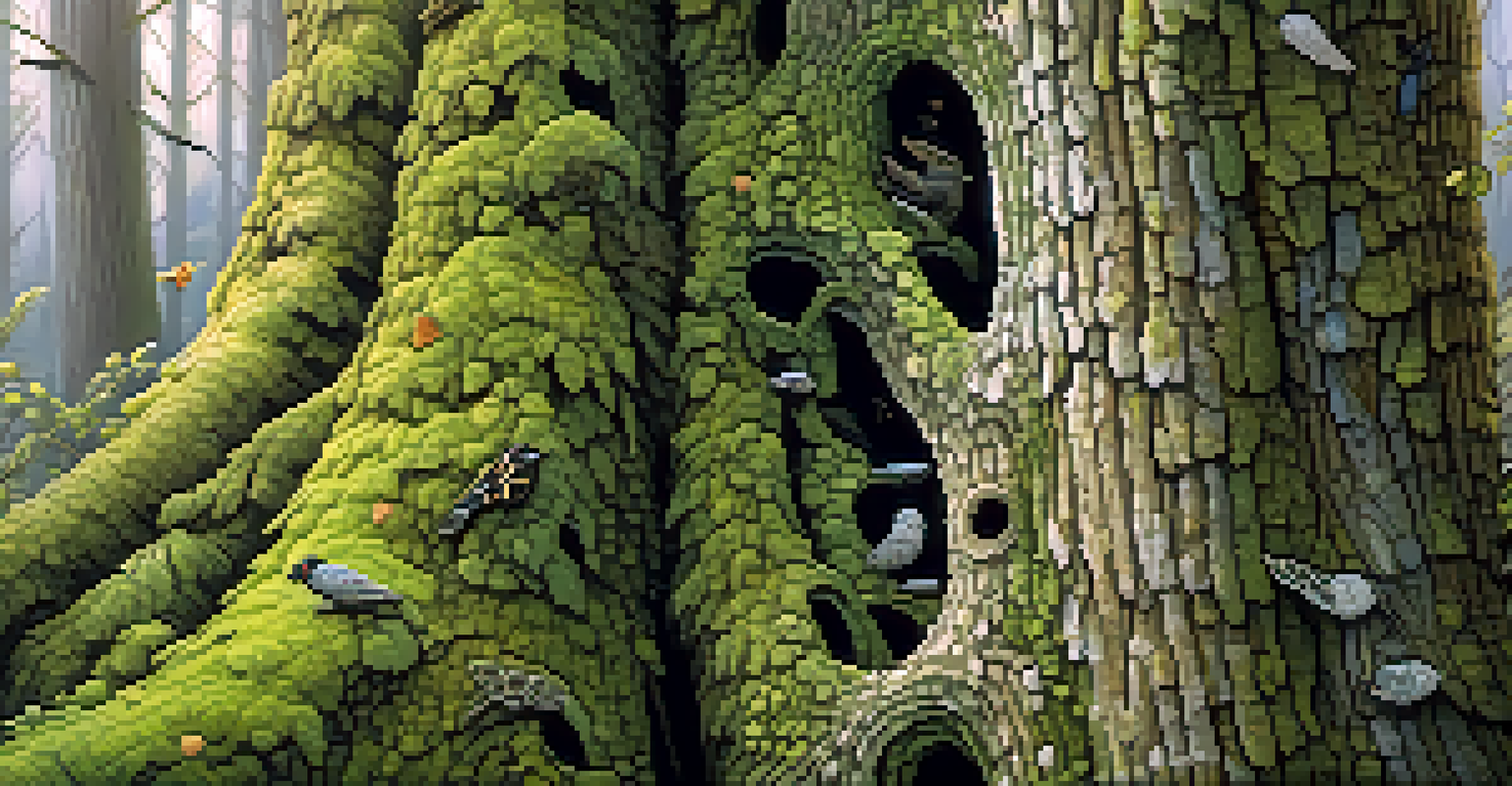The Connection Between Trees and Wildlife Habitat Preservation

Understanding the Importance of Trees in Ecosystems
Trees are often referred to as the lungs of our planet, playing a crucial role in maintaining ecological balance. They provide oxygen, sequester carbon, and support numerous life forms. Without trees, many ecosystems would struggle to thrive, leading to a decline in biodiversity.
The best time to plant a tree was twenty years ago. The second best time is now.
In addition to providing essential resources, trees also create microhabitats that are vital for various species. From birds nesting in branches to insects burrowing in bark, trees offer shelter and food, ensuring that wildlife can flourish. This interconnectedness shows how trees are foundational to healthy ecosystems.
Ultimately, the survival of many animals hinges on the presence of trees in their habitats. As we continue to face environmental challenges, recognizing the importance of trees in ecosystems becomes paramount for conservation efforts.
How Trees Provide Shelter for Wildlife
One of the most significant benefits trees offer wildlife is shelter. The canopies of trees create safe spaces for birds and other creatures to hide from predators. These elevated homes not only protect animals but also provide a vantage point to spot potential threats.

Moreover, the diverse structures of trees—from dense foliage to hollow trunks—accommodate various species. For instance, owls might roost in large tree cavities, while squirrels utilize branches for their nests. This variety illustrates how trees cater to the unique needs of different animals.
Trees Sustain Ecosystem Balance
Trees play a crucial role in maintaining ecological balance by providing oxygen, shelter, and food for various wildlife species.
As urban areas expand, preserving trees becomes increasingly important for maintaining these vital shelters. By prioritizing tree protection, we can ensure that wildlife continues to find refuge amid changing landscapes.
Trees as Food Sources for Wildlife Species
Trees are not just homes; they are also vital sources of food for many species. Fruits, nuts, and leaves provide essential nutrition for birds, mammals, and insects alike. For example, acorns from oak trees are a favorite snack for squirrels and deer, while berries attract a variety of birds.
He that plants trees loves others besides himself.
The relationship between trees and wildlife is symbiotic. Animals help in seed dispersal by consuming fruits and later excreting seeds elsewhere, which fosters new tree growth. This natural cycle not only supports wildlife but also promotes forest regeneration.
By understanding this connection, we can appreciate the role trees play in sustaining wildlife populations. Protecting and planting trees ensures that these natural food sources remain abundant and accessible.
Trees and Biodiversity: A Vital Connection
Biodiversity refers to the variety of life in a particular habitat, and trees are key players in enhancing this diversity. Different tree species attract different wildlife, creating a rich tapestry of life within forests and woodlands. A diverse ecosystem is more resilient and can better withstand environmental stresses.
For instance, a forest with a mix of coniferous and deciduous trees supports a wider array of animals than a monoculture forest. This diversity not only benefits wildlife but also contributes to ecosystem stability and resilience against diseases or pests.
Trees Combat Climate Change
By absorbing carbon dioxide and influencing local weather patterns, trees help regulate the climate and mitigate the effects of global warming.
By fostering biodiversity through tree preservation, we can help maintain the ecological balance crucial for the health of our planet. Each tree planted or preserved plays a role in this intricate web of life.
The Role of Trees in Climate Regulation
Trees are essential in regulating our climate, acting as natural air conditioners. They absorb carbon dioxide, a major greenhouse gas, which helps to mitigate climate change effects. By maintaining healthy tree populations, we can contribute to a cooler, more stable environment.
Moreover, trees influence local weather patterns through transpiration, where they release water vapor into the atmosphere. This process can lead to increased rainfall in certain areas, benefiting both wildlife and agriculture. The presence of trees can significantly impact the microclimate of a region.
As we face global warming and other climate challenges, preserving trees is more critical than ever. By recognizing their role in climate regulation, we can advocate for policies that protect and expand our forests.
Community Engagement in Tree Preservation
Community involvement is vital in preserving trees and their associated wildlife habitats. Local initiatives, such as tree planting events and educational programs, can foster a sense of stewardship among residents. When people understand the benefits of trees, they are more likely to advocate for their protection.
Engaging communities also means creating green spaces that support both humans and wildlife. Urban forests, parks, and gardens can serve as crucial habitats while enhancing the quality of life for local residents. This dual benefit encourages a collective responsibility towards nature.
Community Efforts Enhance Conservation
Community engagement in tree preservation initiatives fosters stewardship and strengthens the relationship between humans and nature.
By coming together to protect trees, communities can make a significant impact on wildlife conservation. Each small action contributes to the larger goal of preserving our planet’s biodiversity.
The Future of Trees and Wildlife Habitats
Looking ahead, the future of trees and wildlife habitats depends on our collective actions today. With ongoing deforestation and habitat destruction, it’s essential to prioritize conservation efforts. Reforestation and sustainable land management practices can help restore lost habitats and promote biodiversity.
Advancements in technology also offer new ways to monitor tree health and wildlife populations. Drones, remote sensing, and data analytics can provide valuable insights, enabling more effective conservation strategies. These tools can help us better understand the intricate relationships within ecosystems.

Ultimately, the connection between trees and wildlife habitat preservation is a shared responsibility. By making informed choices and advocating for sustainable practices, we can ensure a thriving future for both trees and the diverse wildlife that relies on them.